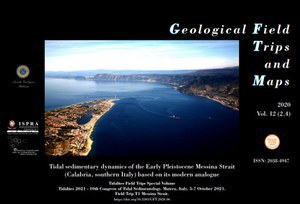Tidal sedimentary dynamics of the Early Pleistocene Messina Strait (Calabria, southern Italy) based on its modern analogue
Tidalites Field Trips Special Volume - Tidalites 2021-10th Congress of Tidal Sedimentology. Matera, Italy, 5-7 October 2021. Field Trip T1 Messina Strait.
The Messina Strait excursion opens a series of geological field trips associated with the 10th International Congress of Tidal Sedimentology (Tidalites), Matera, Italy, 5-7 October 2021. This guide aims at documenting a number of selected outcrops located along the eastern margin of the modern Messina Strait, in order to illustrate the sedimentary dynamics of the Early Pleistocene tide-dominated Messina Strait. Since the Pliocene, this extensional basin separated Sicily from Calabria, forming a wide non-tidal seaway. Successively, this basin turned into a ca. 10-15 km-wide and 40 km-long, tide-dominated strait during the Early Pleistocene, prior to its definitive closure following a Middle Pleistocene phase of tectonic uplift. As for today in its modern analogue, the ancient strait acted as a major conduit for marine water exchanges between the Ionian and the Tyrrhenian seas. Semi-diurnal, reverse bidirectional tidal currents flowed in phase opposition parallel to the strait margins, being subject to tidal amplification due to bathymetric restriction across the shallower strait-centre zone. This oceanographic setting partitioned the strait into specific environments. Nowadays, their sedimentary record is exposed in a series of outcrops across the western (Sicily) and eastern (Calabria) margins of the modern strait. A series of stops along a south-to-north transect covers a total distance of ca. 20 km. Outcrops of the first day show coarse-grained deposits lying adjacent to a block-faulted central horst and transgressively overlain by cross-stratified, mixed bioclastic-siliciclastic arenites. These strata record bypass and residual sedimentation in the strait-centre zone of the ancient strait. The second day, large- and medium-scale cross-stratification exhibiting a variety of tidal sedimentary indicators are observed, interpreted as the ancient northern tidal dune field. The third day focuses on one major section representing the north-eastern flank of the ancient strait, where subaqueous canyon-fill strata, mass-wasting deposits and tide-influenced delta front-facies are exposed.
DOI: https://doi.org/10.3301/GFT.2020.06

